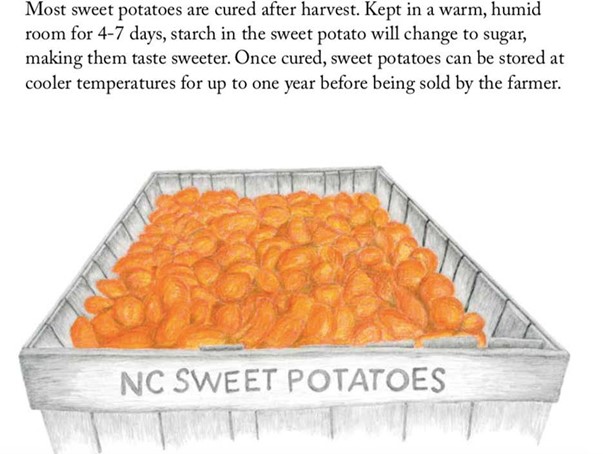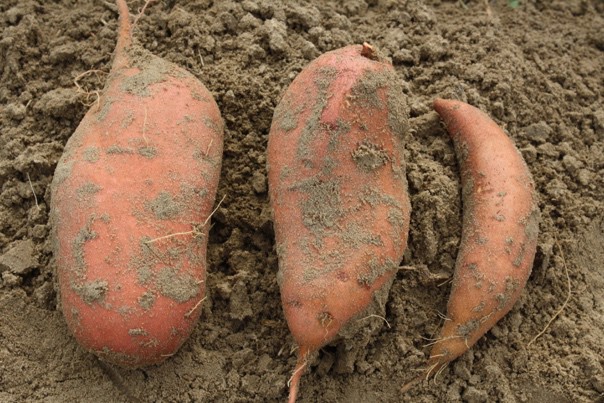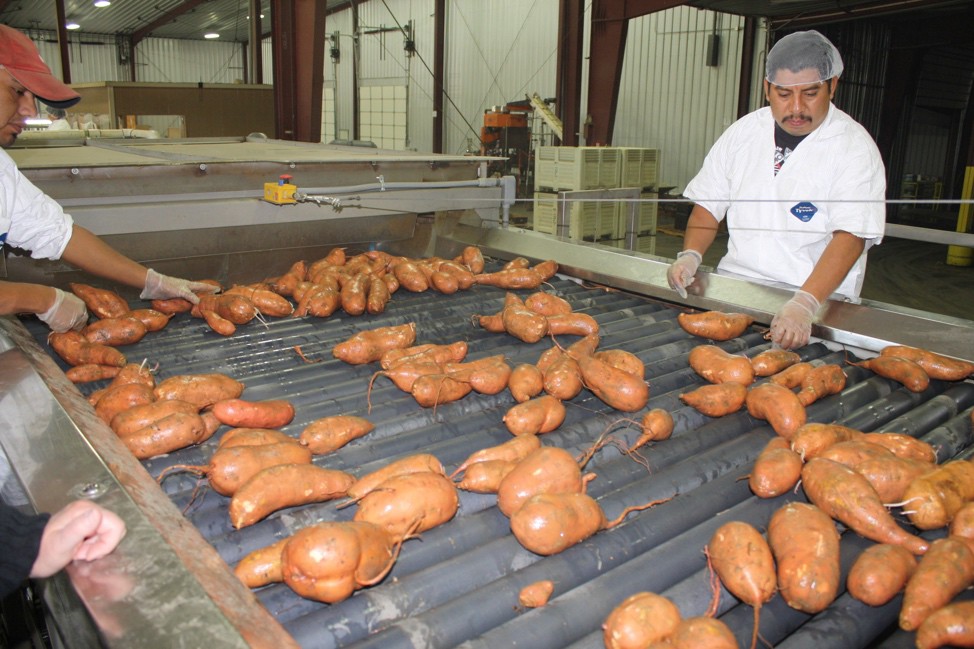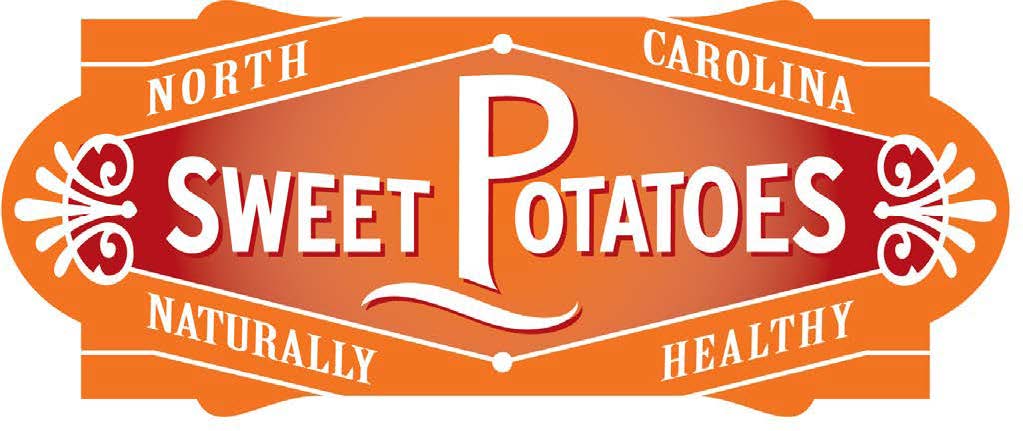Overview
Purpose
Students will identify scientific relatable content within the curing and processing of sweetpotatoes as the final stages of farm to plate.
Subject Area(s)
Science
Essential Questions
- After harvesting sweetpotatoes, what curing process do farmers use?
- What machines are important to the processing of sweetpotatoes?
- Why are sweetpotatoes important to North Carolina, economically and nutritionally?
Materials
- From Farm to School – Crops of North Carolina: Digging for Sweetpotatoes by Heather Barnes and Karen Baltimore (book)
Printed by North Carolina Department of Agriculture and Consumer Services
Publication supported by U.S. Department of Agriculture’s (USDA) Agriculture Marketing Service North Carolina - Technology: Computer/iPad/Chromebook, etc.
- Chart paper
- Markers
- Sweetpotato, talk with a local sweetpotato farmer
- Microwavable sweetpotatoes
- Saran wrap/tin foil/cardboard box/plastic box/etc.
- Microwave
- Measuring cups
- Plastic bags
- Cooked sweetpotatoes
- Cinnamon
- Sugar
- Condensed milk
- Spatula
Essential Files/Links
- From Farm to School – Crops of North Carolina: Digging for Sweetpotatoes (book)
- Health of Sweetpotato Article
- Nutrition Facts Label
- Note Taking Sheet
- North Carolina Sweetpotatoes Ag Mag
- Link to find growers: https://ncsweetpotato.com/sweet-potato-industry/growers/
- https://www.youtube.com/watch?v=PTxL4vrem5o
- https://www.ncfb.org/
- https://www.ces.ncsu.edu/directory/
- https://www.youtube.com/watch?v=g7u6pIfUVy4
- Video: MVI_8085
- Video: MVI_8124
Vocabulary
Agriculture: the science or practice of farming, including cultivation of the soil for the growing of crops and raising animals to provide food, wool, and other products.
Commodity: a raw material or an agricultural product that can be bought and sold such as a sweetpotato.
Consumer: a person who purchases goods and services for personal use.
Curing: preserving of food or animal hide by various methods such as salting, drying, or smoking.
Energy: the process or ability to do work.
Humidistat: (sometimes called a hygrostat) a small measurement device that helps monitor and maintain the relative humidity in the air connected to a humidifier to release moisture in the air to maintain relative humidity.
Kinetic energy: energy an object possesses by virtue of its motion or the calculation of the object’s mass and velocity.
Potential energy: stored energy or energy provided by work that has been done or by its position. Producer: a person, company, or country that makes, grows, or supplies goods or commodities for sale. Storage root: roots that are specifically modified for storage of starch, water, and nutrients such as carrots, beets, and sweetpotatoes. They grow underground as protection from plant-eating animals.
Thermostat: a small measurement tool that measures temperature. It automatically regulates temperature or activates a device when the temperature reaches a certain degree.
Tuber: a thickened underground part of a stem or rhizome, e.g. in the potato, serving as a food reserve and bearing buds from which new plants will grow.
NC Ag Facts
- North Carolina grows nearly 60% of all United States sweetpotatoes (more than any other state in the United States).1
- The sweetpotato is North Caolina’s state vegetable.1 The single-word term helps differentiate the sweetpotato from the white or Irish potato, which is a tuber, not a root, and possess a different nutrient profile. Sweetpotato – Ipomoea batatas, a storage root, is part of the morning glory family. 7
- North Carolina sweetpotatoes are available every month of the year.3
- Most sweetpotatoes are grown in the piedmont and coastal plain regions of North Carolina because of the well-drained, sandy soil.3
- There are hundreds of varieties of sweetpotatoes and many are grown across North Carolina. Some you may see most often in grocery stores include the Japanese sweetpotato, the White sweetpotato, and the orange flesh Covington sweetpotato.3
- In 2017, nearly 89,500 acres of sweetpotatoes were harvested; 30,000 more acres than California, Louisiana, and Mississippi combined.4
- North Carolina has produced more than one billion pounds of sweetpotatoes for the last seven years; this is the only state to exceed one billion pounds.4
- In dollars, North Carolina had the largest increase in 2017 at just over $37 million.4
Background Knowledge
Did you know that sweetpotatoes are actually part of the morning glory family? It is a perennial (perennials regrow every spring); though it is cultivated as an annual (annuals live for one growing season, but often cannot be overwintered). The creeping stems of this amazing plant can grow up to 20 feet long and frequently send out roots at the nodes which, in favorable seasons, bear small potatoes.
There are three main types of leaves: round, shouldered, and lobed or split. The color of the stems and leaves varies from dark green to light purple. No flowers are produced except in southern latitudes.5
The skin color of a sweetpotato can range from white to yellow, red, purple, or brown. The flesh also ranges in color from white to yellow, orange, or orange-red.6
So, is it a yam, a sweetpotato, or are they the same thing? The truth: yams and sweetpotatoes are not the same thing at all. There are thousands of sweetpotato varieties. Sweetpotato varieties are classified as either ‘firm’ or ‘soft’ – firm varieties were produced before soft varieties. When the soft varieties were grown there was a need to differentiate between the two (firm or soft). Africans actually named the ‘soft’ sweetpotatoes ‘yams’ because they resembled the yams in Africa. Their native word was ‘nyami’ and if the n & i are removed the term ‘yam’ remains. Despite this identification, this is not true. In fact, while the ‘soft’ varieties look like yams, they are not yams at all; it is just a variety of sweetpotato.
Yams are often imported from the Caribbean; they are rough and scaly—very different from our smooth, orange flesh variety sold in the United States. In the United States, people often use the word sweetpotatoes and yams interchangeably; however, this is not correct and often adds confusion for the consumer. When a consumer goes to the store and purchases ‘yams,’ they are more than likely purchasing a variety of sweetpotato. Today, the U.S. Department of Agriculture requires labels with the term ‘yam’ to be accompanied by the term ‘sweetpotato.’6
According to the North Carolina Sweetpotato Commission, North Carolina has ranked number one in sweetpotato production in the United States since 1971 (2018). North Carolina’s hot, moist climate and rich, fertile soil are ideal for cultivating sweetpotatoes. Sweetpotato production in North Carolina averages nearly 60% of the U.S. supply.3
Climate
Sweetpotatoes can be grown where there is a long frost-free period with warm temperatures in the growing season.3 Most cultivars require a minimum frost-free period of 90-120 days, with a minimum average daily temperature of 77 degrees Fahrenheit. Sweetpotatoes also require an inch of water per week uniformly distributed throughout the growing season for highest yields.3
Uses for Sweetpotatoes
Sweetpotatoes have many uses. They can be prepared in a number of dishes, canned, pureed, preserved and dehydrated. For drying, clean washed potatoes are placed in a suitable basket and immersed in boiling water for a short time; when taken out of the basket, they are cut into thin slices and spread over mats and exposed to the sun for two or three days. In order to make a superior quality, the skin of the potato is peeled off before slicing. Instances were reported wherein the dried product was successfully ground into flour.5 In North Carolina a company named Glean produces a sweetpotato flour. Sweetpotatoes can also be used as food stock for animals. They have been successfully fed to hogs, cattle, horses and poultry.
How to Play KAHOOT!
Let’s play KAHOOT!!!! If you do not have an account set up, please follow the link here: https://create.kahoot.it/register to register. Once you have registered you may begin creating an interactive game for your students to learn and enjoy. Log into KAHOOT and simply click discussion, survey, multiple choice, or jumble to start making a quiz. Then you will add your questions using the NC Ag Facts and Background Knowledge sections of the lesson plan. Once you have created your Kahoot game, launch the game so players can join. A unique game pin will be provided and players will enter this pin to join. Remember this link: https://kahoot.com/ to be put in the browser of your device (computer, phone, iPad, tablet, etc.) to join the game. Kahoot can be used in many ways to ignite learning in your classroom.
Procedures
Activity 1: Curing Sweetpotatoes
Objectives covered: 6.P.2.2, 6.P.3.1
- After the North Carolina sweetpotatoes are harvested the work is just beginning for this agricultural commodity. In most agriculture operations, farmers add an additional step before sending their crop off to market. This step of the harvesting process is called curing. Ask students what they think this step may involve and accept all answers.
- A sweetpotato is known as a storage root or tuber specifically modified for storing starch, water, and nutrients. Explain to students that curing sweetpotatoes converts starch into sugar, while making the vegetable sweeter and the skin tougher. This process involves the sweetpotato to be kept in large wooden crates while keeping the temperature to 80 – 850F and 90-950F relative humidity for 4-7 days.
- Show page 25, example from From Farm to School – Crops of North Carolina: Digging for Sweetpotatoes by Heather Barnes and Karen Baltimore.

- Explain that simple tools like a humidistat and a thermometer also play vital roles in curing A humidistat (sometimes called a hygrostat) is a small measurement device that helps monitor and maintain the relative humidity in the air. A humidistat is often connected to a humidifier that when needed releases moisture in the air to maintain the necessary relative humidity. A thermostat is a small measurement tool that measures temperature. It automatically regulates temperature or activates a device when the temperature reaches a certain degree. More than likely there is a thermostat in your classroom. Draw students’ attention to this device and explain how vitally important this device is to a farmer who is curing his/her sweetpotato crop before shipping it to the market.
- Obtain several uncured sweetpotatoes and have students make observations. Tell students they are going to create their own examples of curing sweetpotatoes by changing variables such as temperature, humidity, and the amount of light. These are only available at harvest and teachers may need to make arrangements prior to the school year starting. A link to farmers can be found at https://ncsweetpotato.com/sweet-potato-industry/growers/
- Use the Link: https://www.ncfb.org/wp-content/uploads/2020/01/FINAL-ag-mag– pdf to access the North Carolina Sweetpotatoes Ag Mag for students to read about the process of curing and storing.
- After students have read over the information from the link about curing and storing sweetpotatoes, have them summarize the information as seen below connecting it to energy transfer and interactions of matter and energy.
Summary of Information:
- What does it take to cure sweetpotatoes?
- Curing should be started within 1 to 2 hours of harvest and continued for 4 to 7 days at 80 to 85 degrees and 90 to 95% relative humidity with good ventilation for about 5 days.
- Target temperature: 80 to 85 degrees, with a daily average temperature of 77 degrees
- Target humidity: 90 to 95%
- Curing should be started within 1 to 2 hours of harvest and continued for 4 to 7 days at 80 to 85 degrees and 90 to 95% relative humidity with good ventilation for about 5 days.
- What problems may occur?
- Above 60 degrees, but below average target of 77 degrees, can cause internal break down and shrinking and sprouting can occur (sprouting can occur at 65 degrees). Temperatures below 55 degrees may cause hardcore, a disorder where a whitish, hard area appears in the cooked sweetpotato.
- How long can sweetpotatoes be stored?
- Properly cured sweetpotatoes can be stored up to 18 months with little reduction in quality. Shrinkage occurs at 1 to 2% per month if cured, 2 to 5% if uncured.
- Ask students why curing sweetpotatoes can’t be done in the field as a conservation practice and what benefits and challenges do farmers face when curing sweetpotatoes in a warehouse.
- Next, have student groups determine how they want to cure their sweetpotatoes. Allow students to brainstorm ideas of different scenarios and problems that may A few possible curing locations could include a cool, dark, and dry area such as a closet, a plastic bag, a box with aluminum foil or saran wrap, or in the classroom next to a window.
- Show video How to Cure Sweetpotatoes
- Have students come back together and discuss how they should cure the potatoes. Write out a plan of action and carry out the plan. After 6-7 days revisit the potatoes and determine if the curing process was successful.
- For comparison, purchase a few sweetpotatoes from the grocery store or from a sweetpotato farmer and cook both sets of sweetpotatoes to determine the sweetness and texture – farm cured potatoes vs classroom cured potatoes.
- Exit ticket: Ask students to explain the importance of climate and natural resources in North Carolina for growing and curing sweetpotatoes. Do these conditions determine the fact that North Carolina is the top producer of sweetpotatoes in the United States? Could other various technologies be used in colder climates for raising sweetpotatoes, successfully?
Note: Teachers take time to contact your local Farm Bureau, cooperative extension agent, or local sweetpotato farmer who may help provide you with materials to make this lesson even stronger than described to you. **Please note you can complete this lesson without actually curing sweetpotatoes, students can determine from videos what the process looks like.
Farmer: https://ncsweetpotato.com/sweet-potato-industry/growers/
Farm Bureau: https://www.ncfb.org/
NC Cooperative Extension Agents: https://www.ces.ncsu.edu/directory/
Activity 2: Processing Sweetpotatoes
Objectives Covered: 7.P.2.1, 7.P.2.2, 7.P.2.4
- Review the vocabulary terms, energy, potential energy, and kinetic energy with the students and ask for examples. Energy is the process or ability to do work. For any machine to work it has to have energy. Objects can have stored energy, also called potential energy (when work has been done). Kinetic energy is the energy that an object possesses by virtue of its motion or the calculation of the object’s mass and velocity.
- Watch the four minute YouTube video Professor Dave. Have students discuss what they learned from the video and specifically how energy would be involved in processing sweetpotatoes.
- Next, place students into groups of 4-5 and have them watch, discuss, and take notes on the following three videos.
- Show the first video regarding a Sweetpotatoes Packing Facility (MVI_8085)
- Video Summary: This video shows washing and cleaning of sweetpotatoes that are sent through a process to sort them based on size. Give students 5 minutes to discuss examples of energy seen in the processing of sweetpotatoes and use the Note Taking Sheet to record this information (see Essential Files).
- Show the second video, Sweetpotato Production
- Video Summary: This video demonstrates the processes and machines used in processing sweetpotatoes. Have students take note of the way in which the machines work. This process demonstrates how sweetpotatoes are plowed for harvest, sorted, washed, and cut up for making flour. Give students 5 minutes to discuss examples of energy seen in the processing of sweetpotatoes and use the Note Taking Sheet (see Essential Files) to record this information.
- Show the last video about Cleaning and Sorting Sweetpotatoes (MVI_8124)
- Video Summary: This video takes place at a packing facility where sweetpotatoes are taken directly from the field to the packing facility. The sweetpotatoes are carried in large wooden crates, lifted with machinery to be dumped into water, pulled through on a conveyor belt to be cleaned, sorted and more. All of this takes place before reaching the grocery stores, farmers markets, and our tables. Allow students 5 minutes to discuss examples of energy seen in the processing of sweetpotato and use the Note Taking Sheet to record this information (see Essential Files).
- Extension: An alternative to note taking via pen/paper is to create a Padlet account (free) and have students post their comments/summaries about the video to share with the whole class. See website: padlet.com
- Tell the students, “Now that you have seen several examples of how machines and energy are used to process sweetpotatoes, it is time to share out your ideas, what is your take away?”
- Have students demonstrate different examples of kinetic and potential energy. Have them draw an example seen on the videos of kinetic energy and explain their reasoning. Student examples may include machines used in the processing plant, including equipment used to transport the sweetpotatoes for packing and shipping (i.e. forklift, etc).
- Extension Activities:
- Allow students to create kinetic and potential energy projects using random materials found in the classroom, at home, etc. Examples of machines or equipment that push and pull on each other to work.
- OR: Have students write a story based on managing a sweetpotato packing plant, which potato would you select for the consumer and why? Discuss how the role of ethics impacts sweetpotato packing and management of sales. Think about what the consumer (people who eat the sweetpotatoes) likes to eat and how they want it to look. What’s the farmer’s role to ensure he/she produces a good quality product that consumers will buy and enjoy? Remember to reiterate the role of a producer and a consumer. Producer: a person, a company, or country that makes, grows, or supplies goods or commodities for sale. Consumer: a person who purchases goods and services for personal use.


Activity 3: Farm to Plate!
Objectives covered: 6.P.2.2, 6.P.3.1, 8.P.1.3, 8.L.5.2, WHST.6-8.2, WHST.6-8.7
Most every school has a microwave in the teachers’ lounge, or in the school cafeteria. Before the lesson, decide what method to use in regards to cooking or pre-cooking the potatoes.
- Pass around a microwavable sweetpotato (it can be wrapped tightly in saran wrap).
- Allow students to feel the potato (it will be hard, have no smell, etc.)
- Discuss the nutritional value of a sweetpotato. Pass out the Nutrition Facts Label (see Essential Files) for students to view.
- Next, use a microwave to cook one sweetpotato at a time. Minutes: 5 minutes 800 – 1000 watt microwave.
- As the potato is cooking, have students take notes of what they see: moisture, humidity, steam, or change in size (i.e students should illustrate the transfer of heat energy).
- Take out sweetpotato and allow it to cool.
- Pass around microwaved sweetpotato, allow students to lightly press, smell, and feel the potato.
- How has it changed and why? The sweetpotato is soft, you can see juices have formed and the skin has pulled away from the flesh of the potato. Document other observations students notice. Can they smell the sweetpotato, has the size of the sweetpotato changed?
- Discuss with students the process that took place to cook the potato and caused the change.
- Add butter, brown sugar, cinnamon, marshmallows mash up and allow each student to have a Have them read the nutrition facts label of each item they added to the sweetpotato before eating. Did it change the caloric intake of the sweetpotato? Did it enhance the sweetpotato taste?
- Why do consumers eat sweetpotatoes? What are the benefits? Provide students with the informational text found in the Health of Sweetpotato Article (see Essential Files). This is an opportunity to show an emphasis on the relationship between respiration and digestion as energy is used during each process. Have them share what they learned from the article. Ask the following questions:
- What benefits do sweetpotatoes provide for professional athletes?
- If sweetpotatoes are considered to be calorie friendly, what does that mean?
- Can a sweetpotato potentially reduce you from getting sick? If so, how?
- Next, place students in groups of 2 and have them make their own version of sweetpotato pie filling.
Group Activity: Oh, my Sweetpotato Pie!
Instructions:
- Students will select a partner. Students will need measuring cups, 2 plastic bags, cooked sweetpotatoes, cinnamon, and a spatula.
- Students will begin by digging out the inside of the sweetpotato and putting the inside of the sweetpotato in a measuring cup and then place into a plastic bag.
- Students will pour ¼ cup sweetened, condensed milk into the plastic bag with sweetpotato filling. Add a teaspoon of cinnamon.
- Students will then place the plastic bag inside the second plastic bag for extra support. Pass the bag back and forth, allowing each student to mash & mix the ingredients together. Students will notice that the solid and liquid begin to mix together and the color will begin to change slightly. When the solid and liquid have mixed well, it is ready to taste.
- Have students take a spoonful of the mixture and put it on a cinnamon graham cracker to taste.
Concept Elaboration and Evaluation
- After harvesting sweetpotatoes, what curing process do farmers use? Most sweetpotatoes are cured after harvest. To cure sweetpotatoes farmers keep them in a warm, humid place for 4-7 days. The purpose of curing sweetpotatoes is to convert the starch in the sweetpotato into sugar, making them taste sweeter. A cured sweetpotato, if stored properly can be stored for up to 18 months before being sold.
- What machines are important to the processing of sweetpotatoes? Energy is the process or ability to do work. For any machine to work it has to have energy. Objects can have stored energy, also called potential energy (when work has been done) or by its position. Kinetic energy is the energy an object possesses by virtue of its motion or the calculation of the object’s mass and velocity. Sweetpotatoes go through several different processes from the field to a consumer’s fork. Examples of machines used are a forklift, a plow, tractors, etc. The use of machines makes it possible for farmers to not only transplant a larger number of plants, but also to harvest, cure, and pack a larger number of sweetpotatoes to feed the world.
- Why are sweetpotatoes important to North Carolina, economically and nutritionally? North Carolina is the largest producer of sweetpotatoes in the U.S. and this export contributes to the revenue brought into the state and the country through agriculture. Sweetpotatoes are an important food, and historically was a staple food for Native Americans many years ago. North Carolina sweetpotatoes have become a large export to other parts of the world, especially Europe. The importance of the sweetpotato goes far beyond the fields on the farm. Millions of consumers eat them throughout the year for its delicious taste and nutritional value. They are rich in Vitamin A and C and have roughly 100 calories. They have many other vitamins too, including B5, B6, thiamin, niacin, and riboflavin. Health benefits include stabilizing blood sugar, containing antioxidants, boosting brain function, enhancing immunity, promoting vision health, and aid in weight loss.
Suggested Companion Resources
NC Standard Course of Study
Science
6th Grade
6.P.2.2 Explain the effect of heat on the motion of atoms through a description of what happens to particles during a change in phase.
6.P.3.1 Illustrate the transfer of heat energy from warmer objects to cooler ones using examples of conduction, radiation and convection and the effects that may result.
7th Grade
7.P.2.1 Explain how kinetic and potential energy contribute to the mechanical energy of an object.
7.P.2.2 Explain how energy can be transformed from one form to another (specifically potential energy and kinetic energy) using a model or diagram of a moving object (roller coaster, pendulum, or cars on ramps as examples).
7.P.2.4 Explain how simple machines such as inclined planes, pulleys, levers and wheel and axles are used to create mechanical advantage and increase efficiency.
8th Grade
8.P.1.3 Compare physical changes such as size, shape and state to chemicals changes that are the result of a chemical reaction to include changes in temperature, color, formation of a gas, or precipitate.
8.L.5.2 Explain the relationship among a healthy diet, exercise, and the general health of the body (emphasis on the relationship between respiration and digestion).
Additional Standards:
WHST.6-8.2 Write informative/explanatory text, including narration of historical events, scientific procedures/experiments, or technical processes.
WHST.6-8.7 Conduct short research projects to answer a question (including a self-generated question), drawing on several sources and generating additional related, focused questions that allow for multiple avenues of exploration.
National Agricultural Literacy Outcomes
Agriculture and the Environment
- (b) Describe benefits and challenges of using conservation practices for natural resources (e.g., soil, water, and forests), in agricultural systems which impact water, air, and soil quality
- (g) Recognize how climate and natural resources determine the types of crops and livestock that can be grown and raised for consumption
- (h) Recognize the factors of an agricultural system which determine its sustainability
Plant, Animals, Food, Fiber, and Energy
- (b) Explain the role of ethics in the production and management of food, fiber (fabric or clothing), and energy sources
Food, Health, and Lifestyle
- (b) Evaluate food labels to determine food sources that meet nutritional needs
- (g) Identify agricultural products (foods) that provide valuable nutrients for a balanced diet
- (i) Identify sources of agricultural products that provide food, fuel, clothing, shelter, medical, and other non-food products for their community, state, and/or nation
Science, Technology, Engineering & Mathematics
- (d) Discuss how technology has changed over time to help farmers/ranchers provide more food to more people
- (h) Identify specific technologies that have reduced labor in agriculture
Culture, Society, and Geography
- (g) Identify agricultural products that are exported and imported
Sources and Credits
- https://demography.cpc.unc.edu/2017/11/17/nc-in-focus-sweet-potatoes-2017/
- https://statesymbolsusa.org/symbol-official-item/north-carolina/state-food-agriculture- symbol/sweet-potato
- https://ncsweetpotatoes.com/sweet-potatoes-101/how-to-grow-sweet-potatoes/
- https://www.nass.usda.gov/Statistics_by_State/North_Carolina/Publications/County_Estimates/S pdf
- https://archive.org/stream/sweetpotatocultu00pric#page/12/mode/2up
- https://www.loc.gov/rr/scitech/mysteries/sweetpotato.html
- https://cipotato.org/research/sweet-potato/sweetpotato-one-word-or-two/
This publication was supported by the U.S. Department of Agriculture’s (USDA) Agricultural Marketing Service through grant 17-182-2001. Its contents are solely the responsibility of the authors and do not necessarily represent the official views of the USDA.






